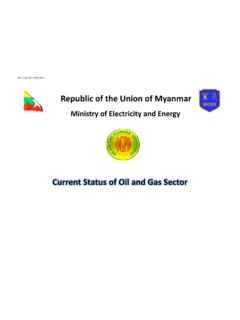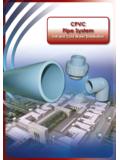Transcription of FOOD SAFETY AND QUALITY STANDARD - Food …
1 Ministry of Agriculture, Livestock and Irrigation 3. GOVERNMENT OF THE REPUBLIC OF THE UNION OF myanmar . Formulation and Operationalization of National Action Plan for Poverty Alleviation and Rural Development through Agriculture (NAPA). Working Paper - 14. 1. food SAFETY AND QUALITY STANDARD . Yangon, June 2016. myanmar : National Action Plan for Agriculture (NAPA). Working Paper 14: food SAFETY and QUALITY STANDARD TABLE OF CONTENTS. ACRONYMS .. iii ACKNOWLEDGEMENTS .. v EXECUTIVE SUMMARY .. vi 1. INTRODUCTION .. 1. 2. BACKGROUND .. 1. food SAFETY and QUALITY in the context of myanmar .. 1. Current status and 3. Types of food SAFETY and QUALITY STANDARD systems in myanmar .. 5. 3. food SUPPLY CHAIN AND CONTROL ACTIVITIES IN myanmar .. 6. Issues and requirements of secondary sectors related to food SAFETY and QUALITY standards .. 8. Government institutions related to food SAFETY and QUALITY standards .
2 9. Ministry of Health (MOH) .. 9. Ministry of Agriculture and Irrigation (MoAI).. 9. Ministry of Livestock, Fisheries and Rural Development (MLFRD) .. 10. Ministry of Industry (MOI) .. 10. Ministry of Commence (MOC) .. 11. Ministry of Science and Technology (MoScT) .. 11. Ministry of Cooperatives (MOCOOP) .. 11. Local government organizations/city development 12. 4. CURRENT POLICIES RELATED TO food SAFETY IN myanmar .. 12. 5. food SAFETY SERVICE PROVIDERS .. 13. food Security Working Group (FSWG) .. 14. food Science and Technology Association (FoSTA) .. 14. myanmar food Processors and Exporters Association (MFPEA) .. 14. myanmar Consumer Union (MCU) .. 14. Tun Win Aung Rural Development Services .. 14. Shan Maw Myae Co., Ltd.. 15. 6. THE AGRICULTURE SECTOR AND food SAFETY / QUALITY .. 15. 7. CONSTRAINTS, OPPORTUNITIES AND EXPECTED RISKS FOR RURAL PEOPLE 15. 8. TECHNICAL ASSISTANCE AND DEVELOPMENT FOR THE PROMOTION OF.
3 food SAFETY AND QUALITY standards .. 16. i|Page myanmar : National Action Plan for Agriculture (NAPA). Working Paper 14: food SAFETY and QUALITY STANDARD United Nations Industrial Development Organization (UNIDO) .. 16. The Adventist Development and Relief Agency (ADRA) .. 17. 9. RECOMMENDATIONS .. 17. ANNEX 1: BIBLIOGRAPHY .. 20. ANNEX 2: Small-scale enterprises in states and divisions in myanmar .. 22. ANNEX 3: Relevant organizations for food testing .. 25. ANNEX 4: Objectives for FSWG interventions in myanmar .. 27. ANNEX 5: Type of village food processing .. 28. ii | P a g e myanmar : National Action Plan for Agriculture (NAPA). Working Paper 14: food SAFETY and QUALITY STANDARD ACRONYMS. ACCP ASEAN Committee on Consumer Protection ACCSQ ASEAN Consultative Committee on standards and QUALITY AEGFS ASEAN Expert Group on food SAFETY ASEAN Association of Southeast Asian Nations DOF Department of Fisheries DOH Department of Health DRD Department of Rural Development EU European Union FDA food and Drug Administration FAO food and Agriculture Organization of the United Nations FIFSTA Federation of Institutes of food Science and Technology in ASEAN.
4 FoSTA food Science and Technology Association FSMS food SAFETY Management Systems GAP Good Agricultural Practice GDP Gross Domestic Product GHP Good Hygienic Practice GMP Good Manufacturing Practice GSP Generalized System of Preferences HACCP Hazard Analysis Critical Control Points IPM Integrated Pest Management LBVD Livestock Breeding Veterinary Department LIFT Livelihood and food Security Trust Fund MAS Myanma Agricultural Services MCDC Mandalay City Development Committee MCU myanmar Consumer Union MFPEA myanmar food Processors and Exporters Association MLFRD Ministry of Livestock, Fisheries and Rural Development MoAI Ministry of Agriculture and Irrigation MOCOOP Ministry of Cooperatives MOC Ministry of Commerce MOH Ministry of Health MOI Ministry of Industry MOScT Ministry of Science and Technology MRL Maximum Residue Level MSTRD myanmar Scientific and Technological Research Department NAPA National Action Plan for Agriculture NCDC Naypyidaw City Development Committee iii | P a g e myanmar : National Action Plan for Agriculture (NAPA).
5 Working Paper 14: food SAFETY and QUALITY STANDARD NGO Non-governmental Organization NHC National Health Committee NHL National Health Laboratory NSPARD National Strategy on Poverty Alleviation and Rural Development SPS Sanitary and Phytosanitary Measures TBT Technical Barriers to Trade UNDP United Nations Development Programme WHO World Health Organization YCDC Yangon City Development Committee iv | P a g e myanmar : National Action Plan for Agriculture (NAPA). Working Paper 14: food SAFETY and QUALITY STANDARD ACKNOWLEDGEMENTS. I would like to express my gratitude to Dr Dilip Kumar, Chief Technical Advisor, for valuable guidance. My thanks are also extended to Dr Le Le Win, National Project Coordinator, for generously spending her valuable time in providing advice and all the national consultants who shared their experiences during compilation of this report. I hereby acknowledge all staff from the Department of Rural Development, Ministry of Livestock, Fisheries and Rural Development, Ministry of Health, Ministry of Commerce and Ministry of Cooperatives as well as the Rector and professors of Yezin Agricultural University and all the people met, who actively shared their experiences and contributed information during my field visits.
6 Last but not least, I also would like to thank all the administration and support staff of the NAPA Project, FAO in myanmar . v|Page myanmar : National Action Plan for Agriculture (NAPA). Working Paper 14: food SAFETY and QUALITY STANDARD EXECUTIVE SUMMARY. myanmar has a diverse and favourable range of agro ecological zones with varying climatic conditions, land QUALITY and suitability for agricultural activities. The country is largely self . sufficient in basic food commodities, with surplus production of rice, pulses and fish in most years. While myanmar is generally food secure at the national level, recent household food security assessments conducted by various agencies confirm that many poor households both in rural and urban areas still face the issues of food insecurity and malnutrition. The steady increase in population size over time has policy implications for all sectors of the economy particularly those relating to education, health, employment and housing.
7 myanmar lags behind various developing countries in many respects as it missed opportunities to participate in numerous global and regional programmes and projects on strengthening food SAFETY , especially in the mid-1990s. Agriculture and the agribusiness sectors make an important contribution to the national economy in myanmar . The specific nature of these sectors varies from country to country in terms of food products, types of technology employed, size of businesses, access to domestic and export markets, and development of GHP, GAP, GMP and HACCP programmes. Among the industries in myanmar , food industries, mainly rice and edible oil industries, constitute about two-thirds of the country's total industry composition. The government assumes responsibility for public health and economic development including improvements in food SAFETY . In this regard, the implementation of GHP/GAP/GMP and HACCP in food businesses is critical to ensure better food SAFETY and QUALITY standards in both export and domestic market areas.
8 As in other countries, the food industry comprises mainly small businesses, which handle a large share of the food consumed. Small food businesses also contribute significantly to the total employment in the food sector and make a vital contribution to the economic well-being of the community at the local level. The government wants indigenous small food businesses to thrive, but with proper public health coverage. Because of the size of the small food business sector, lack of technical expertise, limited economic resources or the nature of their work, difficulties are encountered in implementing food SAFETY measures. There is a lack of awareness, ability and/or unwillingness to comply with basic hygiene procedures. With the rising urban populations in myanmar , street food vending has multiplied and often clusters around places of work, schools, hospitals, railway stations and bus terminals, and so forth.
9 Street food has significant nutritional implications for consumers, particularly for middle- and low-income groups who depend heavily on it. It plays significant nutritional implications at the work place as well as other important locations. For many street food and small food businesses, GHP/GMP/HACCP mean additional cost required for upgrading facilities. Furthermore, hygiene management is also hindered by inadequate local infrastructure. Good hygienic practices are lacking in small food businesses compared to the corporate-level food industry. The adaptation of manufactured foods to international standards of SAFETY , QUALITY and labeling would require more complete food analysis and an extended system of supervision. A major constraint in the implementation of effective controls on food SAFETY in food processing is the lack of laboratory facilities and capacity. However, government organizations, and some private sectors, have established a few QUALITY control laboratories, although their facilities are not of the required STANDARD to provide tests that could be generally regarded as valid and reliable.
10 To a large extent this reflects a more general lack of food SAFETY capacity in both the vi | P a g e myanmar : National Action Plan for Agriculture (NAPA). Working Paper 14: food SAFETY and QUALITY STANDARD public and private sectors. Though there are some basic facilities, these are generally outdated and far below international standards . Strengthening of laboratory systems deserves priority support by providing the required level of precision and/or the laboratory to be implemented with a coherent system of Good Laboratory Practice (GLP), and to be accredited by an outside agency. To harness the potential of the food -processing subsector to enhance livelihoods in myanmar , there is a need to develop food industry clusters in rural areas. As the potential of labour absorption is high in agriculture-based industries and small and medium industries, there is a policy need to provide appropriate openings and avenues by developing industrial clusters and increasing investment in infrastructure to absorb the growing labour force.











